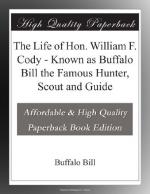“That’s nothing at all,” said I; “I have done it many a time, and old Brigham knows as well as I what I am doing, and sometimes a great deal better.”
So, leaving my saddle and bridle with the wagons, we rode to the windward of the buffaloes, as usual, and when within a few hundred yards of them we dashed into the herd. I soon had thirteen laid out on the ground, the last one of which I had driven down close to the wagons, where the ladies were. It frightened some of the tender creatures to see the buffalo coming at full speed directly toward them; but when he had got within fifty yards of one of the wagons, I shot him dead in his tracks. This made my sixty-ninth buffalo, and finished my third and last run, Comstock having killed forty-six.
As it was now late in the afternoon, Comstock and his backers gave up the idea that he could beat me, and thereupon the referees declared me the winner of the match, as well as the champion buffalo-hunter of the plains.[A]
[Footnote A: Poor Billy Comstock was afterwards treacherously murdered by the Indians. He and Sharpe Grover visited a village of Indians, supposed to be peaceably inclined, near Big Spring Station, in Western Kansas; and after spending several hours with the redskins in friendly conversation, they prepared to depart, having declined an invitation to pass the night there. It appears that Comstock’s beautiful white-handled revolver had attracted the attention of the Indians, who overtook him and his companion when they had gone about half a mile. After surrounding the two men they suddenly attacked them. They killed, scalped and robbed Comstock; but Grover, although severely wounded, made his escape, owing to the fleetness of the excellent horse which he was riding. This sad event occurred August 27, 1868.]
On our way back to camp, we took with us some of the choice meat and finest heads. In this connection it will not be out of place to state that during the time I was hunting for the Kansas Pacific, I always brought into camp the best buffalo heads, and turned them over to the company, who found a very good use for them. They had them mounted in the best possible manner, and sent them to all the principal cities and railroad centers in the country, having them placed in prominent positions at the leading hotels, depots, and other public buildings, as a sort of trade-mark, or advertisement, of the Kansas Pacific Railroad; and to-day they attract the attention of the traveler almost everywhere. Whenever I am traveling over the country and see one of these trade-marks, I feel pretty certain that I was the cause of the death of the old fellow whose body it once ornamented, and many a wild and exciting hunt is thus called to mind.
The end of the track finally reached Sheridan, in the month of May, 1868, and as the road was not to be built any farther just then, my services as a hunter were not any longer required. At this time there was a general Indian war raging all along the western borders. General Sheridan had taken up his headquarters at Fort Hayes, in order to be in the field to superintend the campaign in person. As scouts and guides were in great demand, I concluded once more to take up my old avocation of scouting and guiding for the army.




